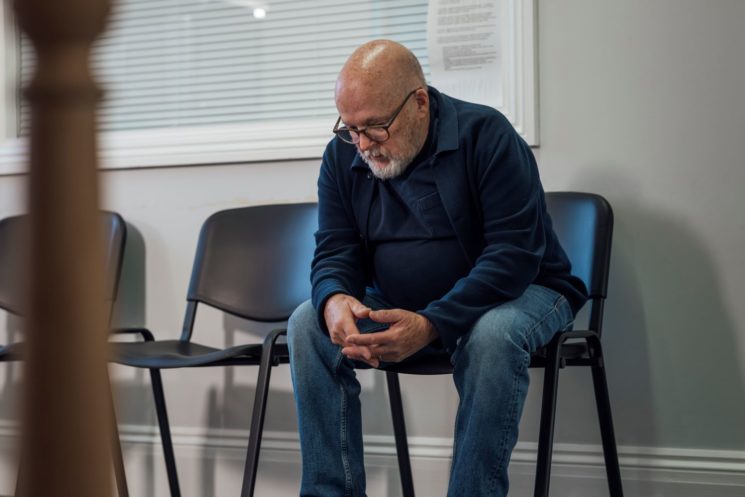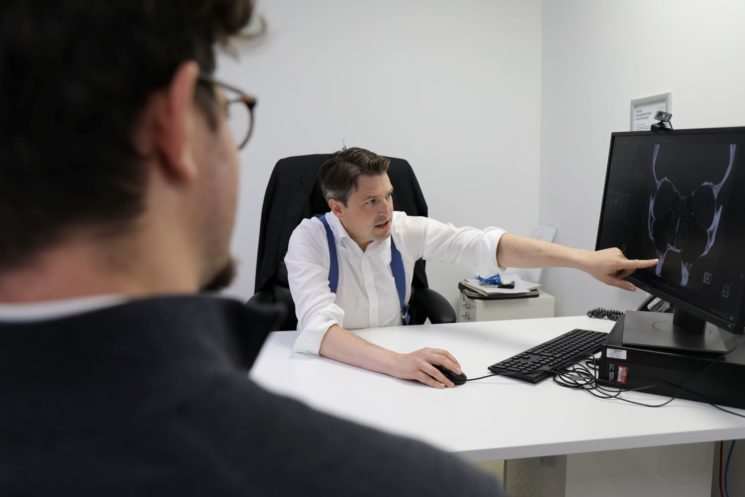
What is sarcoma?
Sarcoma is a type of cancer that can develop in bones and soft tissues across the body. There are more than seventy different types of sarcoma cancer.
The primary symptom of sarcoma is a lump that grows rapidly. Common locations for sarcoma lumps include the legs, arms, and torso.
Soft tissue sarcoma
Soft tissue sarcoma develops in connective tissues around the body, which include fat, muscle, blood vessels, nerves, tendons, ligaments, and joint tissues.
Sarcoma typically presents as a rapidly growing lump. Often this lump is painless at first, but may become painful as it grows larger and presses against other organs or tissues.
Soft tissue sarcoma is a rare type of cancer, with around 4,300 people diagnosed in the UK annually. It’s most common in people aged over 65, who account for around 45% of cases, but does occur semi-frequently in people under 30, who account for around 10% of cases.
You may be at additional risk of developing soft tissue sarcoma if:
- you have certain genetic conditions, including neurofibromatosis type 1 and retinoblastoma
- you have had radiotherapy
- you have been exposed to certain chemicals, including vinyl chloride, dioxins, and phenoxyacetic herbicides
Symptoms of soft tissue sarcoma
The primary symptom of soft tissue sarcoma is a lump.
At first, this lump may be painless. However, it may rapidly grow in size and become painful or sore as it presses against other soft tissues and organs.
Soft tissue sarcoma is rare, and lumps are often benign (non-cancerous), such as cysts or lipoma. However, a lump is more likely to be sarcoma if it:
- is larger than 5cm wide
- is growing in size
- feels like it’s deep with the body tissue
- is painful
- does not move easily under the skin
- develops at an older age
Depending on the location of the lump, you could have other symptoms, such as:
- breathlessness or a cough, if your lump is near the lungs
- a feeling of fullness, if your lump is near the stomach
If you have previously had sarcoma, it’s important you get any new lumps assessed immediately.
Common types of soft tissue sarcoma
There are over 50 different types of soft tissue sarcoma, but two of the most common types are:
- liposarcoma, which develops in fatty tissues around the body. Around 20% of soft tissue sarcoma in adults is liposarcoma, and it’s most common in adults aged between 50 and 65.
- leiomyosarcoma, which is found in smooth muscles (muscles that provide involuntary movement). Smooth muscles are commonly found in the stomach, womb, skin, and limbs.
Diagnostic tests for soft tissue sarcoma
If your GP suspects your lump could be soft tissue sarcoma, they will refer you for testing. You may have:
- MRI scan – this will help your consultant better visualise the lump within your body
- biopsy – a short procedure used to collect a sample of your lump’s tissue for further analysis in a laboratory
If you do have soft tissue sarcoma, these tests will also help your consultant identify how advanced the cancer is and if it has spread.
Treatment for soft tissue sarcoma
If you are diagnosed with soft tissue sarcoma, your consultant will help you to decide on the best method of treatment for your case.
There are usually three core treatments for soft tissue sarcoma:
- surgery – to remove the cancerous lump
- radiotherapy – which uses high-energy radiation to destroy the cancer cells
- chemotherapy – which uses cytotoxic (anti-cancer) drugs to destroy the cancer cells
Bone sarcoma (bone cancer)
Bone sarcoma, also known as primary bone cancer, is a very rare type of cancer that accounts for around 0.2% of all cancer diagnoses in the UK. Primary bone cancer originates within the bones; secondary bone cancer is when the cancer has metastasised from another part of the body.
Bone sarcoma is most commonly found in the legs or upper arm bones.
Symptoms of bone sarcoma
The symptoms of bone sarcoma include:
- persistent bone pain that worsens at night
- inflammation, such as swelling or redness, over the bone
- a lump over the bone
- a weak bone that fractures easily
- difficulty when moving around, e.g. limping
- a high temperature
- unexplained weight loss
- night sweats
Pain from bone sarcoma can occasionally be mistaken for arthritis in older people or growing pains in children and teenagers.
While bone sarcoma is very rare, if you are having worsening bone pain, it is important to see your GP.
Common types of bone sarcoma
There are several different types of bone sarcoma, but the most common are:
- osteosarcoma, which usually occurs in older children and teenagers. It often starts at the end of long bones in the arms and legs, where new bone tissue forms in growing young people.
- chondrosarcoma, which develops in the cartilage cells. Chondrosarcoma can grow both within the bone or on the surface.
- Ewing sarcoma, which is commonly found in younger children and teenagers. There is a soft tissue version of Ewing sarcoma, although it is rarer.
Diagnostic tests for bone sarcoma
If your GP suspects you could have bone sarcoma, you may be referred for the following tests:
- X-ray scan – to look for either bone damage or new bone growth
- biopsy – to collect a portion of bone for further analysis in a laboratory
If you are diagnosed with bone sarcoma, you may have further tests to assess how advanced your cancer is, such as:
- MRI scan – to assess the size of the cancer and if it has spread
- CT scan – to assess if the cancer has spread to the lungs
- bone scan – a type of scan that uses radioactive material injected into the bones to highlight any abnormalities
- bone marrow biopsy – used only if you are diagnosed with Ewing sarcoma, to see if the cancer has spread to the bone marrow
Using the results of these tests, your consultant can assess what stage your cancer is at and whether it has spread.
Treatment for bone sarcoma
If you are diagnosed with bone sarcoma, your consultant will help you to decide on the best method of treatment for your case.
There are usually three core treatments for bone sarcoma:
- surgery – to remove the affected area of bone
- radiotherapy – which uses high-energy radiation to destroy the cancer cells
- chemotherapy – which uses cytotoxic (anti-cancer) drugs to destroy the cancer cells
Where possible, limb-sparing surgery is used to prevent the loss of the limb. The removed bone can usually be replaced with a prosthesis or with bone from another part of the body (bone graft).
If the bone sarcoma has spread or is in a location where limb-sparing surgery is not possible, amputation may be necessary.
Sarcoma treatment at Cromwell Hospital
As part of our partnership with GenesisCare, Cromwell Hospital benefits from having the most advanced radiotherapy centre in Europe. Our facility utilises highly advanced technology for the treatment of tumours, including the Varian Edge and the MRIdian MR Linac.
Patients undergoing chemotherapy can also benefit from the use of DigniCap™, a specialist scalp-cooling cap that helps prevent excessive hair loss, as well as nutritional support from our experienced dietary team.
At Cromwell Hospital, your cancer care will be delivered by a multidisciplinary team of healthcare experts, including world-leading oncologists, surgeons, clinical nurse specialists, dietitians, physiotherapists, and more.



